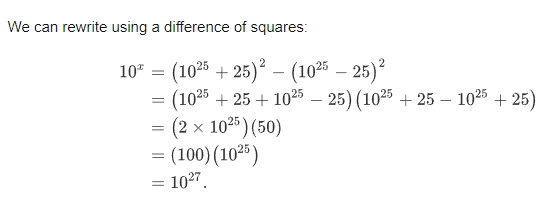Difference of squares? (Also LaTex)
Can someone explain step two of this problem a little bit more in depth to me?
From what I can tell if using the difference of squares
(a - b)^2 = (a + b)(a - b)
10^25 + 25 = a 10^25 - 25 = b
So how exactly does (a - b) = (10^25 + 25 - 10^25 + 25) in step two?
Shouldn't it be (10^25 + 25 - 10^25 - 25)? How does the minus sign in b become a plus?

Also, how do you write Latex on this site? I'm new here and can't seem to get it to work.
/[ 2^{34} /] <- Is this not right?
No vote yet
1 vote
Easy Math Editor
This discussion board is a place to discuss our Daily Challenges and the math and science related to those challenges. Explanations are more than just a solution — they should explain the steps and thinking strategies that you used to obtain the solution. Comments should further the discussion of math and science.
When posting on Brilliant:
*italics*or_italics_**bold**or__bold__paragraph 1
paragraph 2
[example link](https://brilliant.org)> This is a quote# I indented these lines # 4 spaces, and now they show # up as a code block. print "hello world"\(...\)or\[...\]to ensure proper formatting.2 \times 32^{34}a_{i-1}\frac{2}{3}\sqrt{2}\sum_{i=1}^3\sin \theta\boxed{123}Comments
Negative signs are distributive across parentheses i.e. −(x+y)=−x−y. Think of it as multiplying each term by -1. We can write 1025−25 as 1025+(−25), so that
−b=−(1025+(−25))=−1025−(−25)=−1025+25,
and a−b=a+(−b)=1025+25−1025+25, as desired.
Also, welcome to Brilliant! On this site, LATEX is enclosed with \(⋯\) for in-line text or with \[⋯\] for paragraphical text. I hope this answers your questions!
Log in to reply
Man, how did I miss something as simple as the distributive property? I have got a long way to go, huh.
Also, I just realized that latex use backslash, not forwards slash. Oh well, gotta make mistakes before you solve them I guess.
Thanks!